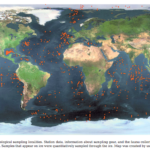
“Less than a month after it was put in orbit, the ocean-mapper Jason-2 has returned its first pictures to Earth.
From an altitude of more than 1,300km, the spacecraft is now feeding back data covering nearly the entire globe.
Jason-2 is set to become the primary means of measuring the shape of the world’s oceans, taking readings with an accuracy of better than 4cm.
The information will be crucial to our understanding of both sea level rise and changing ocean currents.
(snip)
Its key instrument is the Poseidon 3 solid-state altimeter. It constantly bounces microwave pulses off the sea surface.
By timing how long the signal takes to make the return trip, it can determine sea surface height. Additionally, the signal can indicate the height of waves and wind speed.
Elevation is a critical parameter for oceanographers. Just as surface air pressure reveals what the atmosphere is doing above, so ocean height will betray details about the behaviour of water down below.
Jason data gives clues to temperature and salinity. When combined with gravity information, it will also indicate current direction and speed.
The Jason lineage shows that mean sea level has been rising by about 3mm a year since 1993.”
Its cool how you can see a build up of seawater on the western side of the Pacific Ocean. Bonus points for those who can tell us why! (Think waaaaay back to your physical oceanography class if you took one)






I don’t see it in the article, but Jason-2 and similar satellites are extremely important for understanding weather phenomena like El Niño and global warming phenomena like sea level rise. In particular, when an El Niño event occurs, the large warm pool in the West Pacific, which has relatively high sea level, which shows up clearly on the global map above as the large red area in the West Pacific, spreads out, and ‘sloshes’ to the east. On a map like the above, the red the West Pacific would become less intense, but it would also spread out to the east. Correspondingly, the sea levels in the East Pacific would increase. Right now, we are in an ENSO neutral state, but the recent unusual warmth in the East Pacific – which on the map above shows up as an area of relatively high sea levels, or a red to green area in the East Pacific, is suggestive of being closer to an El Niño state rather than a La Niña state.
Just noticed your question. I never took any oceanography classes – and I’ve no grasp of what answer you expect for your question – but I do know there are anticyclonic high-pressure systems in the East pacific that push water to the west, resulting in relatively high sea levels in the West Pacific, and relatively low sea levels in the East Pacific. The weakening of these high-pressure systems is part of the onset of El Niño, and the strengthening is part of the onset of La Niña. The high pressure systems in the East Pacific are also balanced by a corresponding low pressure region in the West Pacific (more or less right over the red area I talked about already). The shape and rotation of the Earth give the high-pressure regions their anticyclonic spin (and, correspondingly, low-pressure regions cyclonic spin), and the sun provides the energy for all of this circulation.